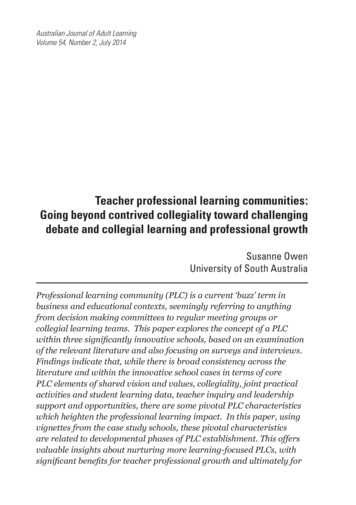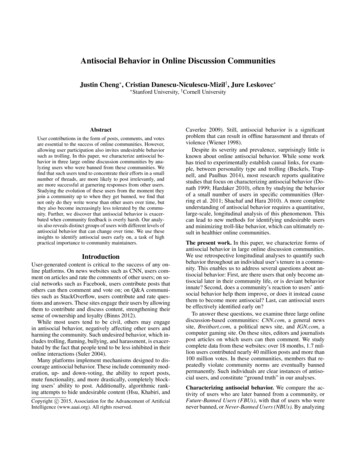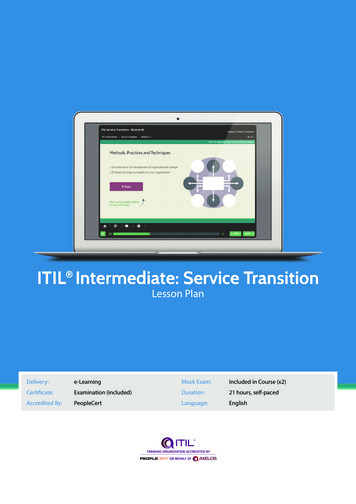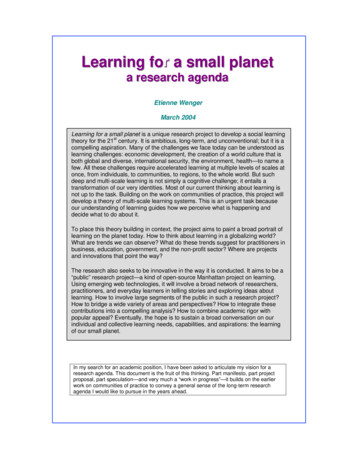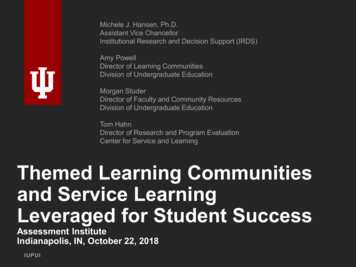
Transcription
Michele J. Hansen, Ph.D.Assistant Vice ChancellorInstitutional Research and Decision Support (IRDS)Amy PowellDirector of Learning CommunitiesDivision of Undergraduate EducationMorgan StuderDirector of Faculty and Community ResourcesDivision of Undergraduate EducationTom HahnDirector of Research and Program EvaluationCenter for Service and LearningThemed Learning Communitiesand Service LearningLeveraged for Student SuccessAssessment InstituteIndianapolis, IN, October 22, 2018IUPUI
Today’s session What are HIPs and why combine Service Learning and LearningCommunities Themed Learning Communities and Service Learning at IUPUI Piloting Service Learning integrated with Learning Communities Assessment Methods and Findings Implications for Practice Discussion/Q&A2IUPUI
Institutional ContextIndiana University-Purdue University Indianapolis(IUPUI) Large Urban Public Research University Student population of about 30,000 students First-Time cohort just over 3,600 and New External Transfers just over1,200 each year The U.S. News and World Report has recognized IUPUI for its outstandingservice learning, civic engagement, first-year experience, and learningcommunities. For 15 consecutive years, U.S. News has highlighted IUPUI for offeringprograms that help ensure a positive collegiate experience for newfreshman and undergraduates. Over 250 degree programs from both Indiana & Purdue Universities,guided by the Principles of Undergraduate Learning About 50% of First-Year students commute to campus and about 40% areFederal Pell Recipients
High-Impact Practices in the First-Year“when I am asked, what one thing we can do to enhance studentengagement and increase student success? I now have an answer: make it possible for every student to participate in at least two highimpact activities during his or her undergraduate program, one in the firstyear, and one taken later in relation to the major field. The obvious choicesfor incoming students are first-year seminars, learning communities, andservice learning.”George D. Kuh (2008)4IUPUI
Markers of HIPs Done Well Expectations set at appropriately high levels Significant investment of time and effort Interactions with faculty and peers Experiences with diversity Frequent and constructive feedback Periodic and structured opportunities for reflection Relevance through real-world applications Public demonstration of competence(Kuh, 2008; Kuh & O’Donnell, 2013)IUPUI
HIP Program Fidelity Fidelity is defined by Webster as “the quality or state of beingfaithful, the accuracy in details, exactness.” Program fidelity assessment offers another level of detail aboutthe program as implemented by examining the degree to whichinterventions are implemented as theoretically planned.– Poor Fidelity Examples LC implemented with no integrative learning assignments. SL implemented with no structured reflection. It is not possible to test the effectiveness of an intervention if theintervention failed to be implemented as planned (Scott &Sechrest, 1989).IUPUI
HIP Benefits and OutcomesHigh Impact practices are positively associated with: Persistence and GPAs Deep approaches to learning Higher rates of student‐faculty interaction Increases in critical thinking and writing skills Greater appreciation for diversity Higher student engagement overallBronwell, J & Swaner, L (2010); Hansen & Schmidt (in press; Journal of The First-YearExperience and Students in Transition); NSSE, (2007); Kuh (2008)IUPUI
The Synergy Of Two High Impact Practices –Learning Communities and Service LearningService LearningThemed Learning Cmtys Fosters sense of communitybelonging Opportunities to analyze and solveproblems in the community. Involve students with “bigquestions” that matter beyondthe classroom. Critical structured reflection. Meaningful experiences with diversepeers and community members. Explore a common topicthrough the lenses of differentdisciplines Sense of purpose and broadenedperspectives. Integration of learningexperiences Hands-on, real world applications oflearning. Engaging pedagogies Co-curricular experiencesModel the idea that giving something backto the community is an important collegeoutcome. Campus engagement Working with community partners is goodpreparation for citizenship, work, and life.8IUPUI
Themed LearningCommunities at IUPUI
LearningCommunities at IUPUI First-Year Seminar 1 ormore disciplinary courses Cohort of 25 freshmen Linked by theme/big idea Out-of-class experiences Integrative connections Sense of belonging
Five attributes of a TLC at IUPUI1. Interdisciplinary theme shapes each TLC course’s design.2. Integration of course content in each TLC course is intentional; coursedesign encourages integrative thinking in students.3. Out-of-class activities enhance academic content, integrativethinking, and interdisciplinary theme.4. Active learning strategies are central to each TLC course.5. Faculty collaboration fosters integrative approach, exploration oftheme, co-curricular experiences, and student development.IUPUI
Service Learning at IUPUI
Service Learning at IUPUIService learning is a course or competency-based, creditbearing educational experience in which studentsa) participate in mutually identified service activities thatbenefit the community, andb) reflect on the service activity in such a way as to gainfurther understanding of course content, a broaderappreciation of the discipline, and an enhancedsense of personal values and civic responsibility.(Bringle & Clayton, 2012; adapted from Bringle & Hatcher, 1996)IUPUI
Service Learning Course ssessmentIUPUIDiversity ofInteractionsand DialogueCriticalReflectionCommunityProject
Service Learning Course AttributesCampus Missionand itutionalType andLocationDiversity ofInteractionsand DialogueCriticalReflectionDuration ofCommunityProjectTeaching ior LearningExperiences ofStudentIUPUI
Service Learning Courses TaxonomyATTRIBUTEHIGH IMPACTHIGHER IMPACTHIGHEST IMPACTReciprocalpartnerships andprocesses shape thecommunity activities,course design, andcommunityoutcomes.The instructor contacts a communityorganization to host students and provides abrief overview of the course (e.g., learningoutcomes, syllabus) and the purposes of thecommunity activities.The instructor meets with the community partner(s)to discuss the course (e.g., preparation/orientationof students, learning outcomes, syllabus), and toidentify how the community activities can enrichstudent learning and benefit the organization.The instructor collaborates with and learns from the communitypartner(s) as coeducators in various aspects of courseplanning and design (e.g., learning outcomes, readings,preparation/orientation of students, reflection, assessment) andtogether they identify how the community activities can enrichstudent learning and add to the capacity of the organization.Community activities The instructor includes community activitiesenhance academicas added components of the course. Thecontent, coursesyllabus conveys this information.design, andassignments.The instructor utilizes the community activities as a“text” to provide additional insight into studentunderstanding of academic content and ability tocomplete assignments. The syllabus describes therelationship of the community activities to learningoutcomes.The instructor integrates the community activities and relevantsocial issue(s) as critical dimensions for student understandingof academic content and ability to complete assignments. Thesyllabus provides a strong rationale for the relationship of thecommunity activities to learning outcomes.Civic competencies(e.g., knowledge,skills, disposition,behavior) are wellintegrated intostudent learningoutcomes.The instructor focuses on discipline-basedcontent with some attention given to civiclearning or development of civiccompetencies.The instructor focuses on discipline-based contentand connects to civic learning and civiccompetencies when relevant to the communityactivities.The instructor focuses on the integration of discipline-basedcontent with civic learning and civic competencies andemphasizes the relevance of the community activities to thepublic purposes of the discipline in society.Dialogue with othersacross difference(e.g., racial, ethnic,social economicstatus, sexualorientation) occursregularly.The instructor, the course, and communityactivities offer students opportunities forinteraction and dialogue with diverse others(e.g., race, ethnicity, social economic status,gender, sexual orientation).The instructor, the course, and community activitiesengage students in periodic interaction anddialogue with diverse others (e.g., race, ethnicity,social economic status, gender, sexual orientation),as well as interactions and dialogue with peersacross a range of experiences and diverseperspectives.The instructor, the course, and community activities engagestudents in frequent interaction and dialogue with diverseothers (e.g., race, ethnicity, social economic status, gender,sexual orientation), as well as interactions and dialogue withpeers across a range of experiences and diverse perspectives.Critical reflection iswell integrated intostudent learning.The instructor asks students to createreflective products about the communityactivities at the end of the semester.The instructor structures reflection activities andproducts about the community activities thatconnect the experience to academic content,require moderate analysis, lead to new action, andprovide ongoing feedback to the studentthroughout the semester.The instructor builds student capacity to critically reflect anddevelop products that explore the relevance of the experienceto academic content, use critical thinking to analyze socialissues, recognize systems of power, and lead to new action.The instructor provides ongoing feedback to the studentthroughout the semester.Assessment is usedfor courseimprovement.The instructor articulates the studentlearning outcomes to the class andassesses at the end of the course.The instructor articulates the student learningoutcomes to the class and uses a measurementtool to assess the service learning component ofthe course.The instructor and community partner(s) articulate the studentlearning outcomes to the class and use measurement tools toassess the service learning component of the course andinfluence on community outcomes.IUPUI
Bringing Service Learningand Learning CommunitiesTogether
Bringing SL and TLCs together. Learning Communities, and Service Learning are High-ImpactPractices (HIPs) - and we know HIPs matter. We also know that quality is important. Having Themed LearningCommunities and Service Learning isn't enough - we must dothem well. 2016 - Institutional Research and Decision Support assessmentthat compared Themed Learning Communities with and withoutService LearningIUPUI
TLC-SL PilotGoals Core group of TLC using SL pedagogies Implementation of high quality SL projects inTLCs Integrative learning, civic learningProcess Attend two half-day workshops (Intro SL, SLIntegration) Service Learning Assistant 5 hrs/week duringimplementation 500 activity fundsIUPUI
TLC-SL PilotFive pilot teams Spring 2017 workshops,team planning Fall 2017 implementationAssessment Faculty survey Student reflections Closing the loopIUPUI
Business: A BusinessGuide to LifeBUS-X 103– Learning CommunityBUS-X 100 – Introduction to BusinessAdministrationCOMM-R 110 – Fundamental of SpeechCommunicationEssential Question:Why should individuals and organizationscontribute to the social welfare of thecommunity?
Liberal Arts: Race,Conflict and PeacefulCommunicationSLA-S 100 –First-Year SuccessSeminarCOMM-R 110 –Fundamentals ofSpeech Comm.SOC-R 100 –Introduction toSociologyEssential Question:How does my identity andcommunication style/skills andawareness of society andcommunity impact my ability towork through and manage conflict?
SPEA: ServiceBeyond SelfSPEA-V 100 – CurrentTopics in Public AffairsSPEA-V 170 –Introduction to PublicAffairsANTH-A 104 – CulturalAnthropologyEssential Question:How are communityissues and concernsconnected to largerscale policy impacts?
Science: Sustainability:Thriving Communities,Thriving PlanetSCI-I 120 – Windows onScienceGEOL-G 107 –Environmental GeologySPEA-V 222 – Principles ofSustainabilityEssential Question:As a critical thinker, how canI apply sustainable solutionsto create thrivingcommunities and a thrivingplanet?
University College:Inequality and SocialJusticeUCOL-U 110 – FirstYear SeminarENG-W 131 – Reading,Writing, and Inquiry ISWK-S 102 – Diversityin a Pluralistic SocietyEssential Question:How do I become asocial justice ally?
Our Approach to Integrating SL into TLCs Five 3-course teams (one of them a FYS) via call for participants Each used a common SL project embedded across the three courses (vsSL solely in one course) Developed common reflection prompts for each team Spring workshops with Patti Clayton Developed a design-thinking tool to help each team plan Assessed level of student academic, civic, and personal growth as well asfaculty development and growth via surveys and student reflectionsIUPUI
Tools and Support Design thinking tool– Givens– Choice points– Table for planning Workshops to share ideas and begin to work with the tool Taxonomies– Themed Learning Communities– Service Learning Service Learning Assistant Scholar Meetings with teams during preparation and implementation (as desired)IUPUI
Design thinking tool 5 givens: Given #1: Each syllabus includes a cover sheet with theme, essential question,and learning outcome for the TLC as well as definition of SL and description of itsrole Given #2: Each course in the TLC will integrate at least one SL-related assignmentor activity Given #3: There are at least 5 distinct LOs toward which the SL project isdesigned:– the TLC learning outcome– academic concept(s) in each course– academic concept(s) in each course in connection with concept(s) in at least oneother course– a civic learning outcome– a personal growth learning outcome Given #4: The team provides at least two opportunities for students to interactwith the full faculty team in or out of the classroom. Given #5: The team assesses both student learning outcomes and communityoutcomes.IUPUI
Design thinking tool 5 choice points: Choice point #1: Options for using the interdisciplinary theme thatconnects the courses in shaping the incorporation of SL in each course inthe TLC Choice point #2: Options for integrating content from multiple courses inSL assignments, including co-creation by all 3 instructors Choice point #3: Nature of the SL component of the course (modularizedor ongoing) along with intensity of instructor involvement Choice point #4: Distribution of SL experience across the courses Choice point #5: Distribution of (the minimum of 5 distinct) SL LOs acrossthe coursesIUPUI
Opportunities and Challenges Opportunities– Faculty learning from one another--more “ambassadors” forparticipating in service learning and integration of HIPs– Increased student civic learning– Broadened and deepened understanding of SL as HIPs Challenges– Time (perennial challenge with SL)– Length of design thinking tool Varied level of experience with both TLCs and SL (not everyone at samelevel with each)IUPUI
Assessment
Assessment Methods Employ Mixed-Method designs using qualitative and quantitative methods. Attempt to understand how TLCs and Service Learning experiencesinfluence students’ success levels (e.g., retention rates, GPAs, engagement,civic outcomes). Administer end-of-course questionnaires (designed to provide information onstudents’ perceptions of course benefits, learning outcomes, satisfactionlevels, why decided to enroll). Administer National Survey of Student Engagement. Conduct focus groups and individual interviews. Collect direct measures of student learning (e.g., embedded courseassessment and e-portfolios). Faculty Survey Designed to Assess Five Attributes or Conditions that Matter.IUPUI
TLC Growth: First-Year Students120010008005656003684002000648755 742800864905 911 8909908526443692531382003 2004 2005 2006 2007 2008 2009 2010 2011 2012 2013 2014 2015 2016 2017 2018IUPUI
2017 TLC Impact on First Year GPA: ANCOVAResultsN Avg. Fall 74Adjusted FallGPA*2.792.73Note 1: Only Full-Time FYS participants. Students who withdrew from a TLC were counted as non-participants. Excludingstudents who were missing data on one or more covariates.Note 2. Differences were statistically significant based on Analysis of Covariance (ANCOVA) results (p . 048).Note 3: Partial Eta Squared indicated a very a small effect size.* Covariates included in the model were High School GPA, SAT Score, Enrollment Date (proxy for student motivation andcommitment), and Income Level (received a Pell Grant or Not dummy coded where 1 Received Pell Grant and 0 Did NotReceive a Pell Grant) and Gender.IUPUI
TLC Participants’ One-Year Retention RatesCompared to Nonparticipants100%TLC Participants90%Nonparticipants80%70%78%68%74%73% 75% 75%79%77%77%75% 77% e: One-year retention rates are significantly higher for TLC participants compared to nonparticipantseven when taking academic preparation and demographics into account for the 2007, 2010, and 2011cohorts (HS GPAs, SAT scores, gender, income level, and admit date). Based on logistic regression results.IUPUI
Underserved Students Participation andOutcomes: 2016 TLCsTLC n(any IU)African American6984%75%Latino(a)/Hispanic8075%Afr. American,Latino,(a)Two or More Races192First GenerationNonparticipantsOne-YearRetention(IUPUI IN)FYGPA2.54N285One-YearRetention(any 7774%70%2.6384768%64%2.55Received FederalPell Grant (proxyfor low income)33275%70%2.571,13368%64%2.56Twenty FirstCentury ScholarsState UI IN) FY GPA67%2.39Bolded items significantly different based on independent samples t-test or chi-squareresults.IUPUI
“While improved retention is a welcomeconsequence of learning-communitywork, it has never been its aim.In the push to improve student retention,it is easy to overlook what research tellsus: Students persist in their studies if thelearning they experience is meaningful, deeplyengaging, and relevant to their lives”(Lardner & Malnarich, 2008).IUPUI
TLCs Engaging ExperiencesSome Items Had Missing Cases. Students’ self-report on end-of-coursequestionnaire.% TLC Students Participating in tyCampusCommunityService orActivityEvent (noVolunteer (speaker, film, service suchworkshop)as festivals,museums)39IUPUI
TLCs Improving Students’ Interactions with Diverse Others,Sense of Community, and Application of Knowledge (Fall 2017)Please indicate how much your experience in the Themed Learning Community helped you NMeanNot at allVery littleLittleSomePercentagesMuchVery muchWork well with others who differfrom me (with regard to religiousbeliefs, gender, ethnicity, culturalbackground, race, etc.)3875.111.61.02.816.834.942.9Form one or more friendships thatI will maintain after the semester3885.082.81.84.914.227.349.0Consider problems and issuesfrom multiple perspectives/point ofview (ethnic, racial, cultural,religious, etc.)3894.942.32.64.917.234.738.3Apply what I learned in one courseto another course in my learningcommunity3884.911.52.86.219.832.037.6Feel connected with other IUPUIstudents3894.852.62.65.920.633.435.0Develop a better understanding ofcomplex real world problems orissues3884.842.13.45.920.134.833.81 Not at all, 2 Very Little, 3 Little, 4 Some, 5 Much, 6 Very muchIUPUI
Top 5 N 189 (two themes tied at #5)Total N of Comments 279IUPUI
Top 5 N 266Total N of Comments 291IUPUI
Top 5 N 138Total N of Comments 169IUPUI
Faculty Survey: TLCS as High ImpactPractices and Attributes/Conditions thatMatterSurvey Method:1. Administered to all faculty teaching in Themed Learning Communities viaQualtrics link.2. The response rate for the TLC Faculty survey was 95.3%. 121 out of 127responses were collected. It is a required survey so opted into agreeing touse results for research purposes.3. There was one faculty member that indicated they did not want to be apart of the research. N reported here is 120.4. There were a few faculty that taught multiple TLCs. 127 number is thenumber of individual links that were sent out but there were 113 facultymembers.IUPUI
Faculty Survey Indicators of Conditions thatMatter - Taxonomy40%35%30%25%20%15%10%5%0%Interdisciplinary theme shapes each course'sdesign34%34%21%11%Less than High High impact TLC Higher ImpactImpactTLCIUPUIHighest ImpactTLC
Faculty Survey Indicators of Conditions thatMatter - TaxonomyCourse design encourages integrative thinking s than High High impact TLC Higher ImpactImpactTLCIUPUIHighest ImpactTLC
Faculty Survey Indicators of Conditions thatMatter - TaxonomyOut of class activities enhance academic content,integrative thinking, and interdisciplinary theme40%35%30%25%20%15%10%5%0%36%28%29%Less than High High impact TLC Higher ImpactImpactTLCHighest ImpactTLC7%IUPUI
Faculty Survey Indicators of Conditions thatMatter - TaxonomyActive learning strategies are central to s than High High impact TLC Higher ImpactImpactTLCHighest ImpactTLC5%IUPUI
Faculty Survey Indicators of Conditions thatMatter - TaxonomyFaculty Less than High High impact TLC Higher ImpactImpactTLCIUPUIHighest ImpactTLC
TLCs with Service LearningNumber of Student Participants600490500400300293278Fall 2014Fall 20155192001000Fall 2016Fall 2017TLC Service Learning50IUPUI
TLC-Service Learning Participants’ One-YearRetention Rates Compared to TLC No ServiceLearning and Nonparticipants (no TLC or SL)100%TLC-Service LearningTLCNon-Participants90%82%80%74% 73%77%78%74%75%73% 72%70%60%50%40%201520162017Note: One-year retention rates were significantly higher for TLC-Service Learning participants compared to TLC andnonparticipants even when taking academic preparation and demographics into account for the 2015 cohort and higher thannonparticipants for the 2016 cohort (HS GPAs, SAT scores, income level, and admit date). Based on logistic regression results.IUPUI
TLC-Service Learning Participants’ One-YearCUM GPAs Compared to TLC No ServiceLearning and Nonparticipants (no TLC or SL)TLC-Service LearningTLC 782.76 2.742.802.71 2.692.602.402.202.00201520162017Note: One-year GPAs rates were significantly higher for TLC-Service Learning participants compared to TLC and nonparticipantseven when taking academic preparation and demographics into account for the 2014 and 2015 cohorts (HS GPAs, SAT scores,income level, and admit date). Based on ANOVA results.IUPUI52
TLC-Service Learning: Integrative LearningMean 3.923.534.053.714.073.73UnderstandApply what I learned Consider problems andconnections betweenin one course toissues from multipledifferent disciplines and another course in my perspectives / points ofcourseslearning communityview (ethnic, racial,cultural, religious, etc.TLC-Service LearningTLC No Service LearningNote 1: All items significantly different based on independent samples t-test results. TLC-SL N 223,TLC No SL N 105Note 2: Responses based on a 6 point Likert-Type scale where0 Not at All, 1 “Very Little”, 2 “Little”, 3 “Some”, 4 “Much”, and 5 “Very Much”53IUPUI
TLC-Service Learning: Civic EngagementOutcomesMean 4.063.66Develop a betterunderstanding ofcomplex real worldsocial problems orissues4.053.693.973.70Apply knowledgeApply course conceptsgained in learningto my own lifecommunity courses toexperiencesbroader community orsocial issuesTLC-Service LearningTLC No Service LearningNote 1: All items significantly different based on independent samples t-test results.TLC-SL N 476, TLC No SL N 216Note 2: Responses based on a 5 point Likert-Type scale where 1 “Very Little”, 2 “Little”, 3 “Some”,4 “Much”, and 5 “Very Much”IUPUI54
2018 National Survey of StudentEngagement High Impact PracticesFirst-Year StudentsSeniorsIUPUI students significantly more likely to participate in Learning Communities,Service Learning, Internships, and Capstones (culminating senor experiences)IUPUI
NSSE 2018 Results: HIP Participation FirstYear StudentsLearning Community, Undergraduate Research, Service LearningNumber of HIP Participated Three“Two” represents Themed Learning Community-Embedded First Year Seminar and ServiceLearning. Do not emphasize undergraduate research in FY.IUPUIResults shown for N 11 may not be reliable.
NSSE 2018 Results HIPs – CollaborativeLearning50.00Means Collaborative Learning Scoresby Number of High Impact Practices First neOneTwoThreeEach EI is scored on a 60-point scale. To produce an indicator score, the response set for each item is converted to a 60point scale (e.g., Never 0; Sometimes 20; Often 40; Very often 60), and the rescaled items are averaged. Thus ascore of zero means a student responded at the bottom of the scale for every item in the EI, while a score of 60 indicatesresponses at the top of the scale on every item.IUPUI
NSSE 2018 Results HIPs – Discussions withDiverse Others FY StudentsMeans Discussions with Diverse Others byNumber of High Impact Practices First eeEach EI is scored on a 60-point scale. To produce an indicator score, the response set for each item is converted to a 60-point scale (e.g.,Never 0; Sometimes 20; Often 40; Very often 60), and the rescaled items are averaged. Thus a score of zero means a studentresponded at the bottom of the scale for every item in the EI, while a score of 60 indicates responses at the top of the scale on every item.IUPUI
NSSE 2018 Results HIPs – Reflective andIntegrative Learning60.00Means Reflective and Integrative LearningScores by Number of High Impact PracticesFirst 10.000.00NoneThreeEach EI is scored on a 60-point scale. To produce an indicator score, the response set for each item is converted to a 60point scale (e.g., Never 0; Sometimes 20; Often 40; Very often 60), and the rescaled items are averaged. Thus ascore of zero means a student responded at the bottom of the scale for every item in the EI, while a score of 60 indicatesresponses at the top of the scale on every item.IUPUI
Students’ ReflectionsDeeper Understanding Diversity and Senseof Self Emerge as Themes
Students’ Reflections- “I’ve learned a lot about race, especially in aspects I didn’tthink to focus on or notice, like environmental racism orempowerment I learned that there is so much more toracism than just police brutality or hate crimes it stretchesso much farther. It really opened my eyes to racism, the factthat it stretches into all areas of life.”- “As a white female, I have many opportunities and privilegesthat many people of color do not get. It was interesting tolearn and see for myself all of the racial injustice going onaround me. It really opened my eyes to see the importanceof standing up for racial injustice in the world and made mewant to be more helpful.”IUPUI
Students’ Reflections-“In general I just started to notice all of the waste everyone around me wasproducing, myself included. I started to recycle more, I have a lot more reusablecups now, I produce less food waste, etc. Now I’m just trying to have my familyfollow suit. For me, the experience where I developed a deeper understanding forsustainability and others was the day we did our service project.”-“They have taken well to this so I’m hoping to convince them to start a garden withnative fruits/vegetables, to buy more sustainable products, and to in general startconsidering all that they waste in a day. I’m hoping to start having us use lesswater and electricity, maybe convert to 100% natural gas with IPL, drive less, etc.”IUPUI
OutcomesFaculty Learning and Development“For the first time, I saw the service project as an artifact - much like thearticles, books, videos and websites I've used for decades in analysiswriting.”“It has really helped me to clarify how to help students communicate andhave open conversations about issues involving race.”“I have been more satisfied with my teaching and with the quality of studentlearning. I also feel that I have been able to broaden my students’understanding of civic involvement and have them more prepared to speak inpublic.”IUPUI
Implications for Practiceand Discussion
Implications for Practice Faculty development Providing students with opportunities for reflection Integrative learning assignments Intentionally linking themes with SL experiences Using assessment results for program improvements65IUPUI
Discussion and QuestionsIUPUI
Michele J. Hansen, Ph.D.Institutional Research and Decision an StuderDirector, Faculty and Community ResourcesCenter for Service and Amy PowellDirec
and Service Learning Leveraged for Student Success Assessment Institute Indianapolis, IN, October 22, 2018 IUPUI . to the community is an important college outcome. Working with community partners is good preparation for citizenship, work, and life. . recognize s

